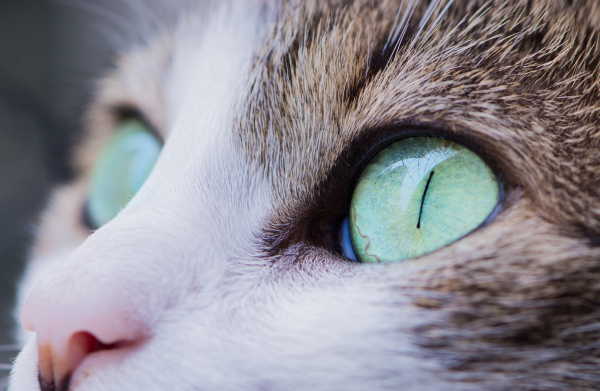Kočka divoká se vrací
Kočky divoké patří mezi nejvzácnější šelmy naší fauny. V minulosti lov a ztráta přirozeného prostředí způsobily jejich vymizení. Po šedesáti letech to ale vypadá, že se do našich krajin opět vrací.
The whiskers on cats’ face are probably too noticeable to ignore them. But do you know all the places where cat’s whiskers with sense of touch are? And do you know how this comprehensive tactile body functions?


The sense of touch is one of the fundamental senses for cats. It is partially because of the fact that their vision is not very good. You have certainly noticed that cats are sensitive to touch or that they wince when something touches their whiskers. Some cats even don’t like to drink from a bowl when their whiskers touch it. There are many nerve cells and nerve endings in the skin on the entire body of the cat. The most of them are on the pad of their feet and around their muzzles. They also have tactile hair (whiskers) which are rooted as much as three times deeper in the skin than the rest of the hair. Moreover, they have large number of extremely sensitive nerve endings at their roots.
The roots of the individual tactile hair are stored in separate ligament bursas and have their own large arrector pili muscles. Let’s look closer to tactile hair which are also called sinus hair. You can find them on the upper lip, on the cheeks, the chin, above the eyes, in the armpits and on the lower side of the front paws. They are longer and thicker than the rest of the cat fur. They regularly fall out and get renewed the same way as the usual hair. But you shouldn’t cut them in any circumstances! When the cat loses some tactile hair in the natural process of renewal, it is okay. If you cut them, it becomes disoriented and it can start to crash into things and it will be rightfully restless.
You may have heard that the hair length corresponds to the widest part of the cat’s body and this helps to tell whether it can stretch into a hole. But scientists have never confirmed that. Also, the length of the cat’s hair depends on its breed. How do tactile hair work? The cat can perfectly orient in space and avoid the obstacles even in a dark environment not only thanks to its vision but thanks to its hair. It is based on observing the air flow. The tactile hair are so sensitive that they can sense the least noticeable movement. As the air flows around objects, the cat is capable of noticing the obstacles and avoiding them. Therefore, blindness is not such a big problem for cats and they can move in space quite well (at least horizontally) even without vision.
Moreover, there are four types of nerve endings in the roots of hair and when the hair touch the obstacle, the cat can sense the pressure, its direction, speed and duration. The cat is also able to sense the changes in the atmospheric pressure thanks to its tactile hair. The hair on cat’s face also reflect its mood. When they are upright, it is in a good mood and it lowers them to its cheeks for defence or when it is angry. When exploring a new object, it turns the hair forward. But it also uses its front paws when getting acquainted with new things. As you can see, it would be very difficult for cats without hair because they are an important part of their body.


Kočky divoké patří mezi nejvzácnější šelmy naší fauny. V minulosti lov a ztráta přirozeného prostředí způsobily jejich vymizení. Po šedesáti letech to ale vypadá, že se do našich krajin opět vrací.


Takzvané pet friendly kanceláře, kde si zaměstnanci mohou do práce přivést svého psa, jsou čím dál modernější. Trend se ovšem nezastavuje jen u psů, v některých firmách si zvířátko pořídí dokonce nastálo. Vedle rybiček dělají pracantům společnost...


Název psinka je vám možná povědomý, znáte ale přesnější charakteristiku tohoto zákeřného virového onemocnění? Vezmeme to pěkně od historických kořenů po současnost.


Pravděpodobně mezi svými přáteli máte i někoho s cukrovkou. Víte ale, že tímto onemocněním trpí poměrně často i psi a kočky?


Pro jedny děsivá noční můra, pro druhé ráj na zemi. To jsou kavárny, kde vám společníky dělají kočky.


Jistě při shánění vánočních dárků myslíte i na své kočičí členy domácnosti. Ostatně kdyby ne, oni by vám to nikdy neodpustili :).


Víte, jaké sny mají vaši domácí mazlíčci? Tato otázka zajímala kromě mě i nemálo vědců, kteří přicházejí s různými hypotézami. Tipnete si, o čem se zdá vašim čtyřnohým parťákům?


Psincový kašel je infekční onemocnění horních cest dýchacích, velmi často se vyskytující právě na podzim a na jaře. Víte, jak ho poznat a jak před ním svého čtyřnohého parťáka chránit?


Pejska ani kočku nechcete, přesto ale toužíte po nějakém chlupatém mazlíčkovi, který se vám neztratí v náručí? Tento malý obr je pak možná právě to, co hledáte.


Pokud váš pes žije celoročně venku, je třeba mu k tomu zřídit vhodné podmínky. Jeho bouda musí být dobře zateplená a musí být i dobře konstruovaná. Zde je pár tipů, jak na to.


Minule jsem se s vámi podělila o mé názory na kastrace obecně a vyjmenovala výhody a nevýhody tohoto zákroku u fen. Teď se pojďme podívat, jak je to u psů.


Kastrace je stále celkem ošemetné a velmi konzultované téma. Já vám dnes představím fakta o tomto zákroku a o jeho důsledcích a podělím se také o svůj názor.